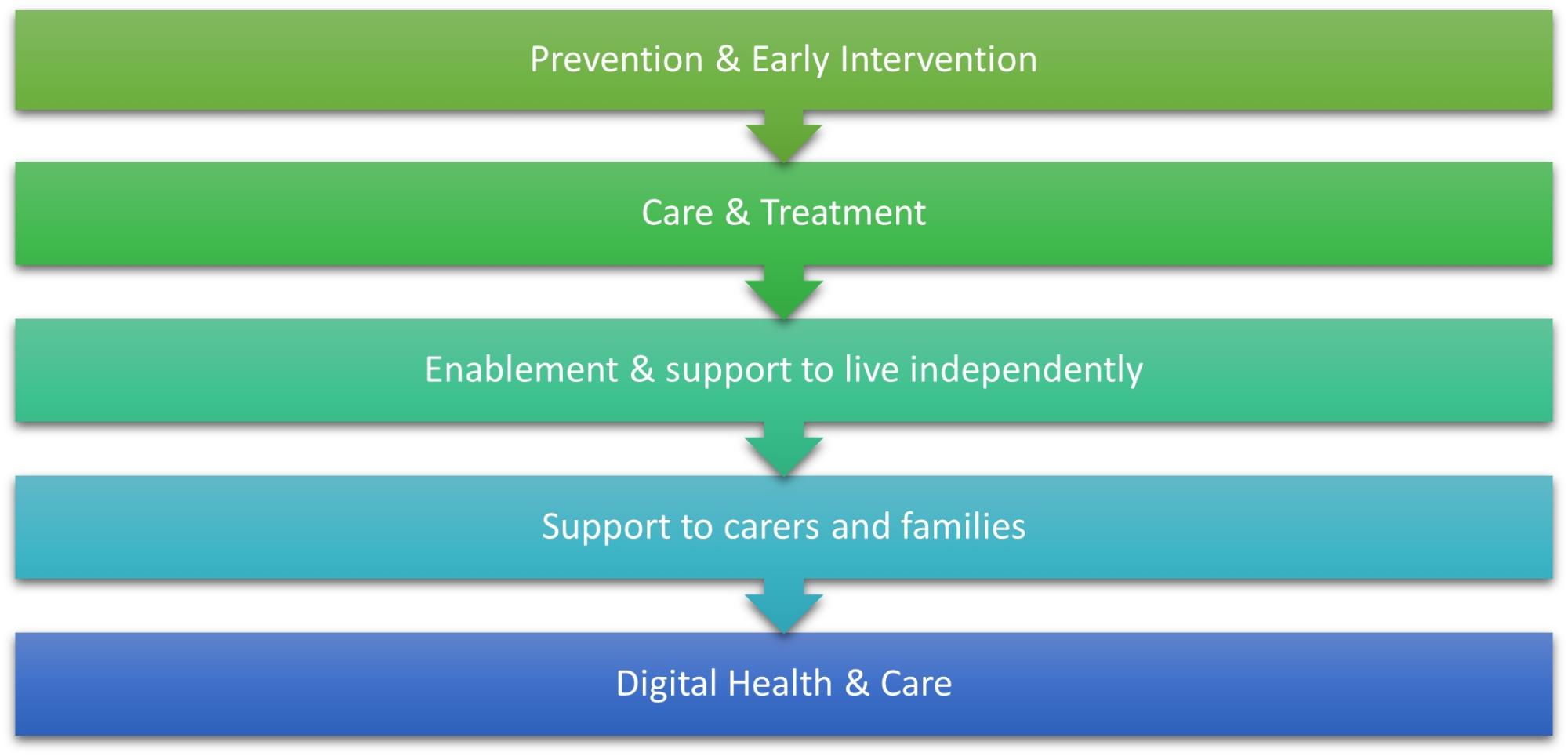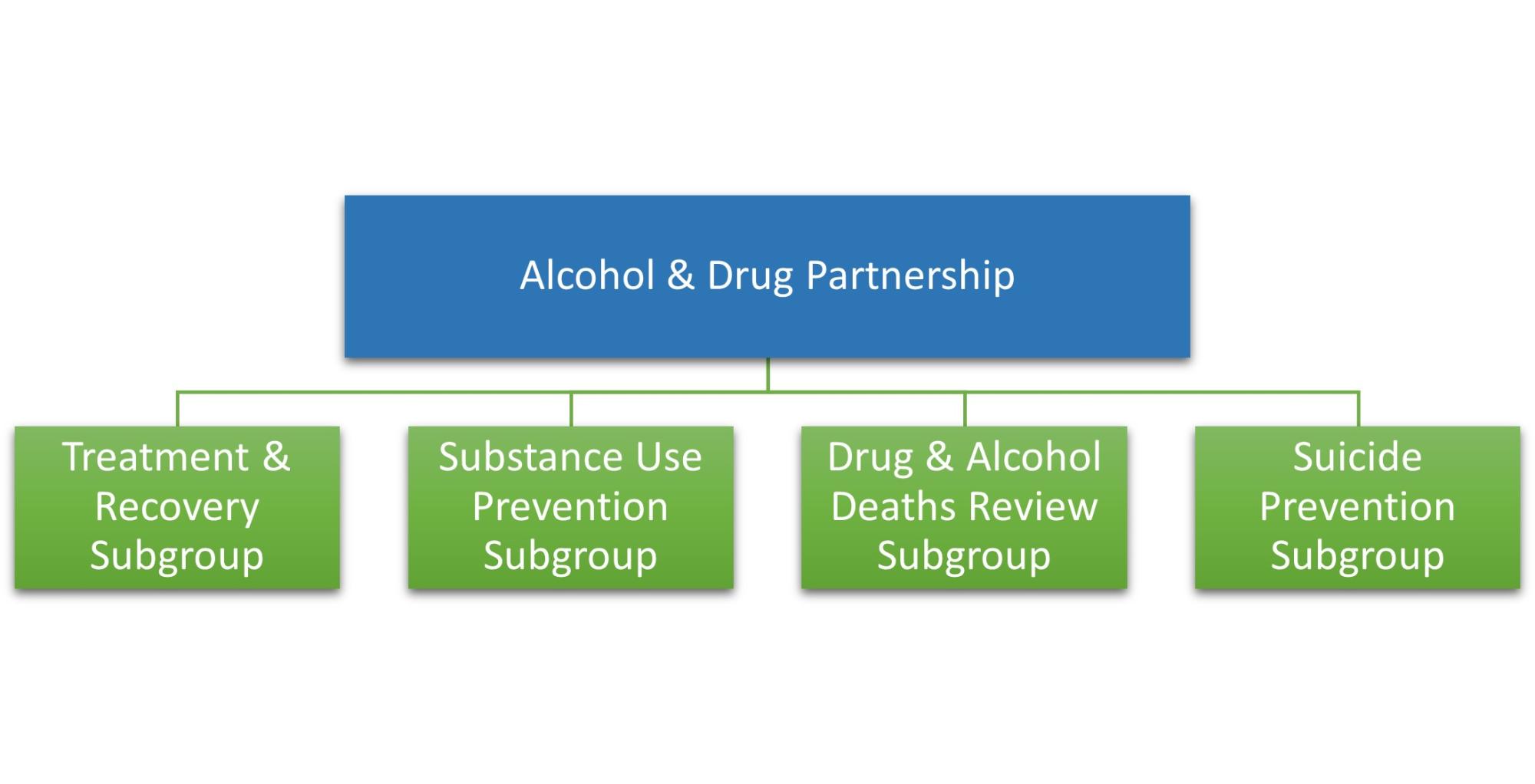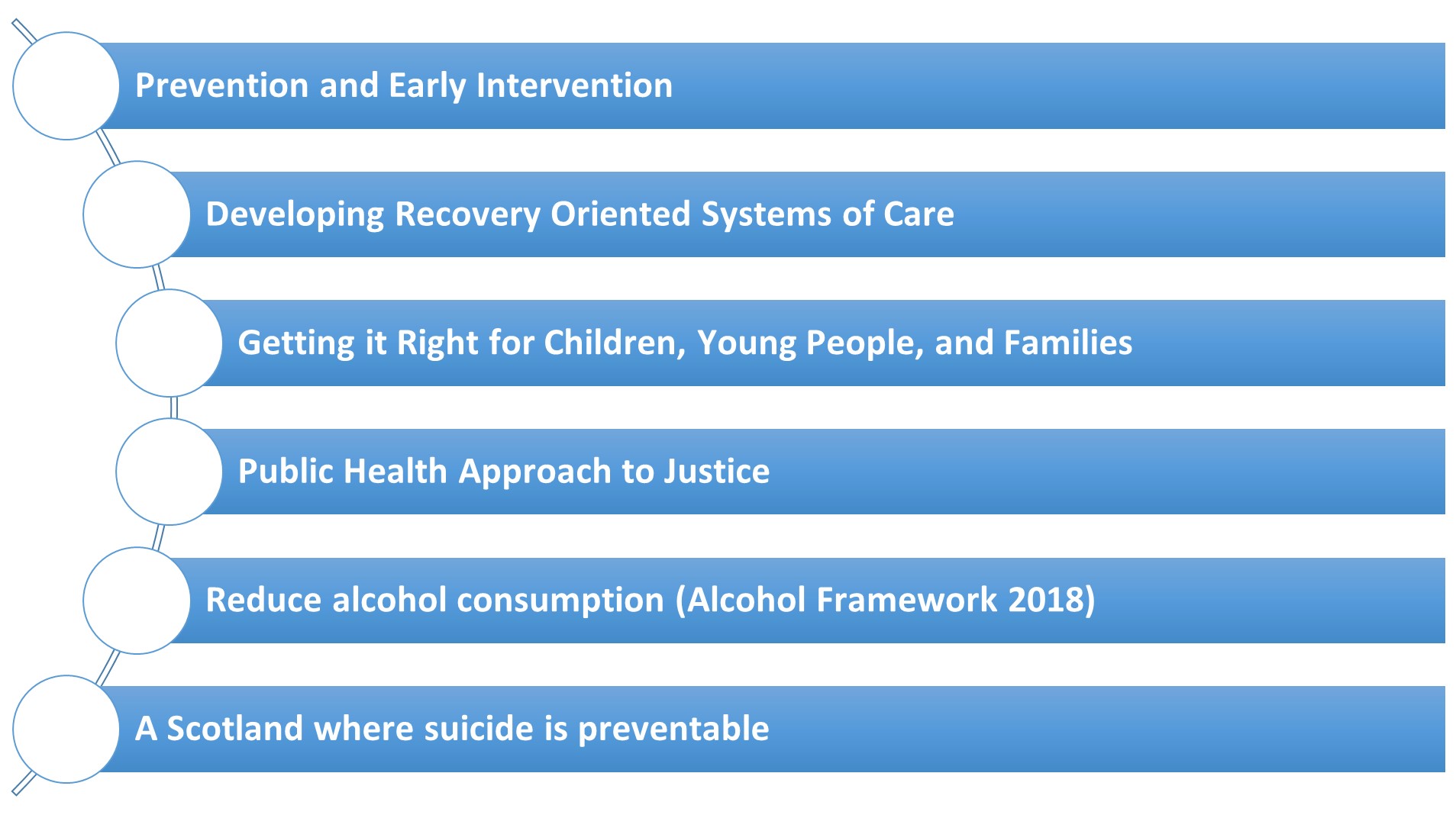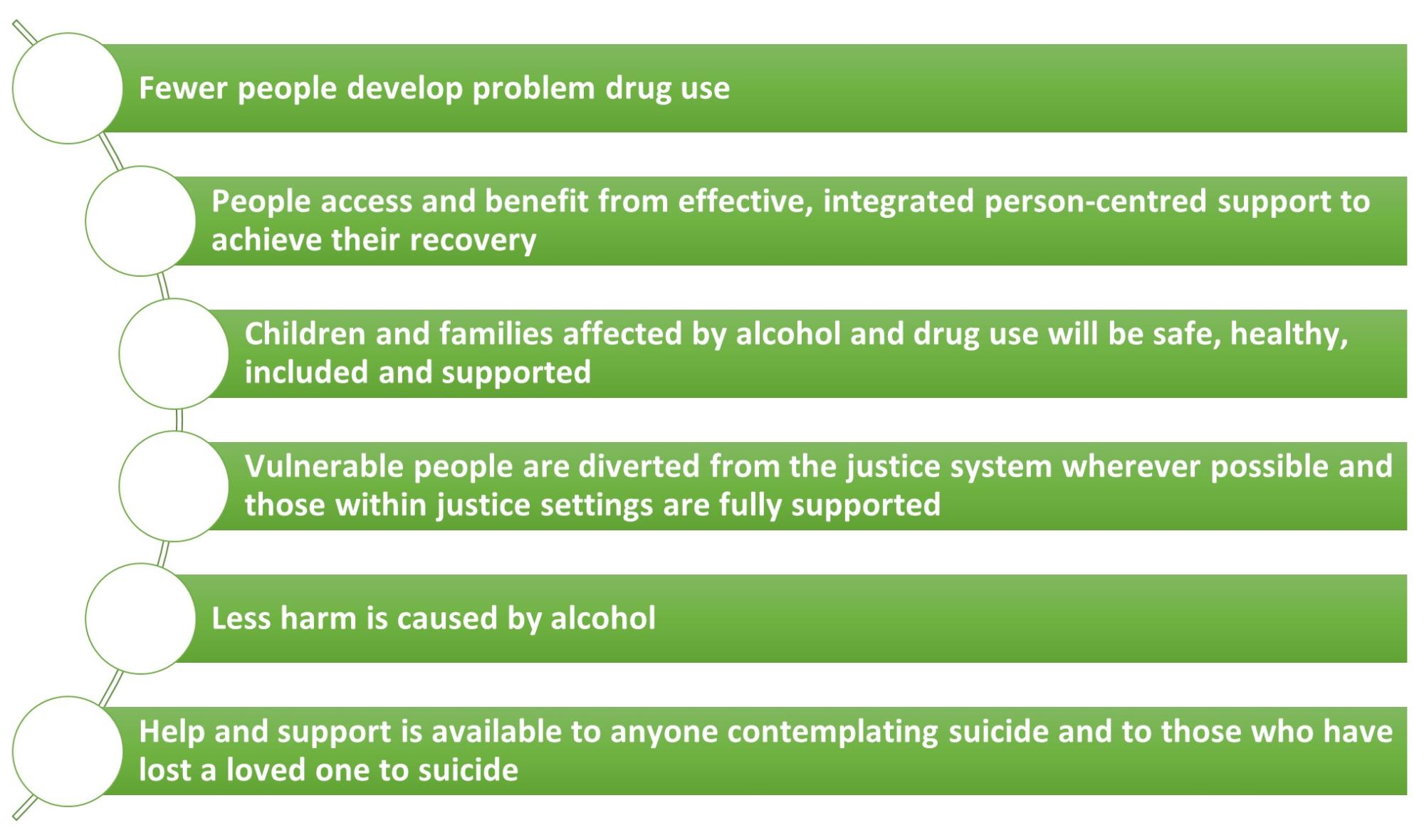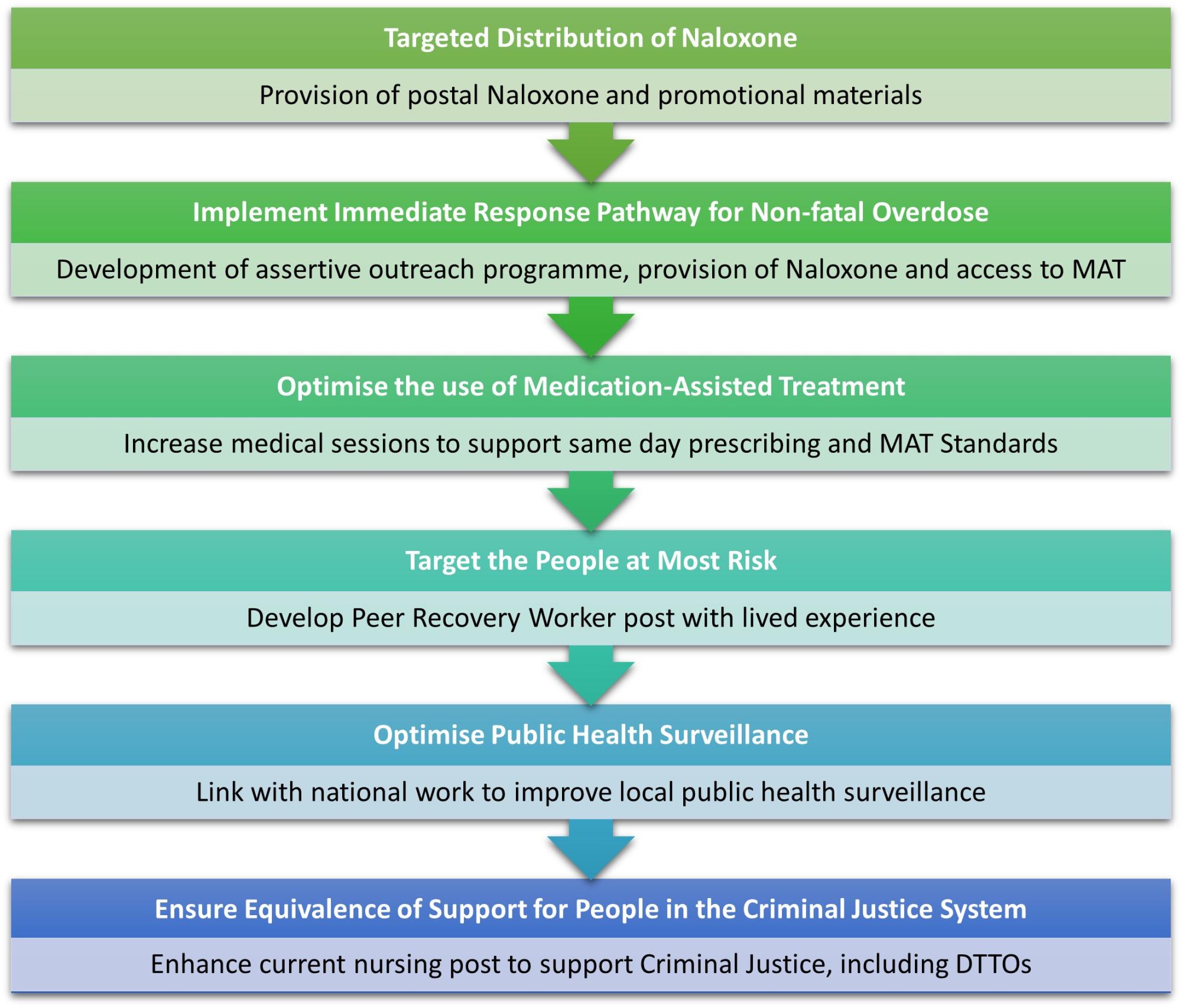The Alcohol and Drug Partnership (ADP) continues to develop treatment and recovery service provision to help improve the lives of people who use alcohol and drugs problematically in East Dunbartonshire, their families, carers and communities.
East Dunbartonshire Alcohol and Drug Partnership Strategy (2020-2023) supports ‘Rights, Respect and Recovery: Scotland’s strategy to improve health by preventing and reducing alcohol and drug use, harm and related deaths’ ensuring individuals, families and communities:
- Have the right to health and life – free from the harms of alcohol and drugs;
- Are treated with dignity and respect;
- Are fully supported within communities to find their own type of recovery.
Taking a whole population approach to recovery, East Dunbartonshire Alcohol and Drug Partnership’s focus is on supporting multi-morbidity, including embedding trauma and suicide prevention within practice. To enable this approach, the ADP commissioned an independent needs assessment, including gap analysis across commissioned Mental Health and Problematic Substance Use services to ensure future investment, service development and support is more cross-cutting, joined up and more reflective of a whole system approach to recovery.
Building on the work of our Recovery Orientated System of Care, the ADP Strategy and Delivery Plan will support the implementation of, and embed the priorities and outcomes of Rights, Respect and Recovery and the Alcohol Framework and include the six evidence-based strategies established by the Drug Deaths Taskforce.
Investment and resources will focus on both treatment and recovery ensuring that services encourage and compliment an individual’s person-centred pathway with the maximum choice available. Services will be trauma informed, provide equality, diversity and respect and challenge stigma, embracing innovation and utilising lived experience.
The ADP will continue to work together as a partnership to support prevention, early intervention, and harm reduction across drugs and alcohol. Reducing inequalities, improving community relationships and involving service users and carers at the centre of service development.
On this page you can find information on:
- Introduction
- Vision
- Demographics
- Policy Context
- Governance
- Priorities
- Outcomes
- Drug Related Deaths
- Reshaping Services
- Investment
- Consolidating Learning from Covid-19
- Additional ADP Priorities 2023-25
- Contact Details
Introduction
The East Dunbartonshire Alcohol and Drugs Partnership (ADP) is a multi-agency partnership tasked by the Scottish Government to coordinate alcohol and drug services through partnership working. ADP Membership includes East Dunbartonshire Health & Social Care Partnership, East Dunbartonshire Council, NHS Greater Glasgow and Clyde (NHSGGC), Police Scotland, HMP Low Moss, the Scottish Fire and Rescue Service and representatives from the Recovery community.
Vision
National Vision
Scotland is a country where “we live long, healthy and active lives regardless of where we come from” and where individuals, families and communities:
- have the right to health and life – free from the harms of alcohol and drugs;
- are treated with dignity and respect; and
- are fully supported within communities to find their own type of recovery.
East Dunbartonshire Vision
“The ADP will work in partnership to improve the lives of people who use alcohol and drugs problematically in East Dunbartonshire, working to strengthen resilience and capacity to reduce harms of problem Alcohol and Drug use within communities, families and individuals in East Dunbartonshire.”
Demographics
The East Dunbartonshire Area Profile 2020 document provided by Corporate Performance and Research provides an overview of the population of East Dunbartonshire including a number of key findings, populated from sources such as the 2011 Census.
Further detail on the East Dunbartonshire Area Profile can be found on the National Records of Scotland website. Population growth between the 2001 and 2011 Census provided below including the latest population estimate in East Dunbartonshire 108,640, projected to grow to 112,399 by 2028, with 36% of the current population over the age of 65 (39,555).
Census Population
| Area | 2001 Census Population | 2011 Census Population | Difference between 2001 and 2011 censuses |
|---|---|---|---|
| East Dunbartonshire | 108,243 | 105,206 | -3,217 |
Population by Age
| Area | Total Population | 0-15 | 16-64 | 65+ | 75+ | 85+ |
|---|---|---|---|---|---|---|
| East Dunbartonshire | 108,640 | 19,398 | 64,766 | 24,476 | 11,726 | 3,353 |
| East Dunbartonshire % | - | 17.9% | 59.6% | 22.5% | 10.8% | 3.1% |
| Scotland % | 5,463,300 | 16.9% | 64.0% | 19.1% | 8.5% | 2.3% |
Policy Context
National
In 2018, ten years after the publication of the previous alcohol and drugs strategies, Scottish Government published two strategic documents to address alcohol and drug harm:
- Rights, Respect and Recovery - Scotland’s strategy to improve health preventing and reducing alcohol and drug use, harm and related deaths. Read more on the Rights, Respect and Recovery website.
- Alcohol Framework 2018 - next steps on changing our relationship with alcohol. Read more about the Alcohol Framework 2018.
In 2019, COSLA Leaders and Scottish Ministers approved the Partnership Delivery Framework to Reduce the Use of and Harm from Alcohol and Drugs; this framework which can be read on the Scottish Government website, sets out the shared ambition between Local Government and Scottish Government to support the development and implementation of local ADP Strategies and Delivery Plans.
Public Health Priorities for Scotland which can be read on the Scottish Government website represents an agreement between the Scottish Government and Local Government to focus on improving the health of the population.
Priority 4: A Scotland where we reduce the use of and harm from alcohol, tobacco and other drugs, provides a public health approach looking at the root causes of harm and focuses on what we can do to make a difference.
‘Every Life Matters’ the new Scottish Suicide Prevention Action Plan was launched in 2018 to continue the work from the 2013-2016 suicide prevention strategy, with a target to further reduce the rate of suicide by 20% by 2022. Suicide Prevention is included within the ADP Strategy to ensure a whole population approach as ‘Every Life Matters’. Please see addendum for updated Suicide Prevention Strategy and Action Plan.
Local
As well as the links to national strategies, the work of the East Dunbartonshire Alcohol and Drug Partnership is guided by several local strategies and plans:
* These local Strategic Plans will end and refresh during the implementation of the ADP Strategy.
- East Dunbartonshire Local Outcome Improvement Plan (LOIP) 2017 -2027
- East Dunbartonshire Health and Social Care Partnership Strategic Plan 2018-2021*
- East Dunbartonshire Joint Health Improvement Plan 2018 -2021*
- East Dunbartonshire Commissioning Strategy & Market Facilitation Plan 2019 – 2022*
East Dunbartonshire Local Outcome Improvement Plan (LOIP) 2017 -2027 which can be read on the Council's website, local outcomes 3, 5 and 6:
Local Outcome 3 – Our children and young people are safe, healthy and ready to learn.
Local Outcome 5 - Our people experience good physical and mental health and wellbeing with access to a quality built and natural environment in which to lead healthier and more active lifestyles.
Local Outcome 6 - Our older population and more vulnerable citizens are supported to maintain their independence and enjoy a high quality of life, and they, their families and carers benefit from effective care and support services.
East Dunbartonshire Health and Social Care Partnership Strategic Plan 2018-2021 which can be read on the council website, includes strategic priorities for Drugs and Alcohol under priorities 1, 2 and 8:
Priority 1
- Revise and improve our services to those suffering harm through alcohol and substance abuse.
- Develop pathways within community payback orders to increase the use of specific alcohol, drug and mental health requirements and interventions to promote healthy living and risk reduction.
Priority 2
- Roll out our Recovery Orientated System of Care (ROSC) service model, which establishes closer links to communities for individuals with Alcohol & Drugs and/or Mental Health issues.
- Implement an alcohol intervention and education programme, establishing closer links to partners and communities to raise awareness and reduce alcohol related harm.
Priority 8
- Support the national priority for the implementation of the rollout of the Drugs & Alcohol Information System (DAISy) across alcohol and drugs services.
Joint Health Improvement Plan - Key Priority 3 – Alcohol and Drug, Intervention and Awareness:
- Improve accessibility and uptake of Alcohol Brief Interventions within Primary Care and Community settings.
- Increase capacity of partners to deliver Alcohol Brief Interventions to their service users.
- Deliver a suite of alcohol and drugs training across local communities and partners staffing teams to raise awareness of the impact alcohol has on people’s health.
- Deliver community alcohol and drug campaigns providing support and increasing capacity to licensees across East Dunbartonshire.
- Deliver a range of interventions to determine compliance with enforcement legislation, including reducing access to illicit alcohol.
East Dunbartonshire Commissioning Strategy & Market Facilitation Plan, commissioning themes:
Governance
East Dunbartonshire Alcohol and Drug Partnership (ADP) is responsible, with local partners, for commissioning and developing local strategies to tackle problem alcohol and drug use and promote recovery, based on an assessment of local needs. The ADP in East Dunbartonshire is a multi-agency partnership whose membership is comprised of NHSGGC, East Dunbartonshire Alcohol & Drug Service, Police Scotland, Housing services, Scottish Fire and Rescue Service, Licensing, Third Sector providers, Community Safety Partnership, Community Justice Partnership, Mental Health Services, Children’s Services, and Education and Leisure services.
Reporting is via the ADP Coordinator through contributions from ADP members, national data, and local statistical information, and then signed off by the ADP Chair before going to the Integrated Joint Board for approval then submission to the appropriate bodies.
The ADP is aligned to public protection partnerships, with representation from the ADP within the Community Justice and Community Safety Partnerships. The ADP meets on a quarterly basis with ADP representatives also attending any national and GGC Board wide meetings where required.
The following groups also feed into the ADP:
- Treatment and Recovery Subgroup (T&R)
- Substance Use Prevention Subgroup (SUPG)
- Drug and Alcohol Death Review Subgroup (DADR)
- Suicide Prevention Subgroup (SP)
Priorities
East Dunbartonshire ADP will work in partnership to deliver the priorities below, focusing investment and resources on reducing the use of and harm from alcohol and drugs.
Outcomes
East Dunbartonshire ADP will focus on the following outcomes, in line with Rights, Respect and Recovery, and the Alcohol Framework, as further highlighted within the delivery plan.
Drug Related Deaths
The Drug Deaths Taskforce established six evidence-based Strategies to reduce drug deaths and drug harms:
- Targeted Distribution of Naloxone
- Implement Immediate Response Pathway for Non-fatal Overdose
- Optimise the use of Medication-Assisted Treatment
- Target the People at Most Risk
- Optimise Public Health Surveillance
- Ensure Equivalence of Support for People in the Criminal Justice System
East Dunbartonshire ADP were successful in gaining funding from Scottish Government to support the actions below. It is the aim of the ADP to ensure work against these actions becomes sustainable and embedded in practice where possible.
Reshaping Services
In 2019, the East Dunbartonshire Health and Social Care Partnership commissioned an independent mental health and substance use needs assessment across contracted services. The aim of the needs assessment was to provide a baseline of current service provision, analyse service duplication and gaps, and provide a set of recommendations for reshaping services over the next five years.
By reshaping future services across the commissioned landscape, we can ensure they are more joined-up and aligned to national and local policy. Services will support multi-morbidity and embed good practice around trauma informed care, addressing crosscutting service requirements, including support for individuals who are harder to reach.
The ADP will work in partnership with ADP members, service users, carers, third sector partners and other relevant stakeholders to reshape mental health and substance use commissioned services over the next five years. A separate action plan will ensure that the priorities and outcomes of the ADP Strategy are deeply rooted in this process.
Investment
There has been investment across both treatment and recovery services since the ADP’s inception in 2009. In 2011, the ADP commissioned its first needs assessment; based on the recommendations, investment focused towards recovery, which also supported the development of the local ROSC. There was significant investment into services to support children, young people and other family members affected by substance use as well as a Community Rehabilitation Service.
Based on the outcomes from the 2019 needs assessment, drug related taskforce funding and the priorities and outcomes from the national strategies; the ADP will continue to invest in prevention, early intervention, treatment and recovery. Reconfiguring investment to ensure current service needs remain supported and that the priorities and outcomes noted in this document and the ADP Delivery Plan are realised.
Consolidating Learning from COVID-19
The COVID-19 Pandemic changed the way we delivered services, with current working practices being adapted quickly, to ensure service users stay supported whilst keeping both service users and staff safe. In April 2020, ADRS’s and ADPs provided a response to Scottish Government around the continuation of drug and alcohol services to ensure services continue to be safe and accessible. Service changes implemented on a day-to-day or week-to-week basis in line with national and local guidance, some examples below:
- Local COVID-19 plans were implemented, based on the national guidance provided.
- All cases were risk assessed on the ‘Risk Level Matrix’ into a traffic light system of Critical, Substantial, Moderate and Low risk.
- Daily vulnerable persons reports were scrutinised to ensure contact was being maintained with people most at risk.
- Contact was agreed based on the assessed risk – Face-to-Face, telephone contact and online/video resources.
- Assessments completed by telephone unless high risk identified.
- Mandatory use of PPE was introduced.
- 28-day prescribing was introduced, with increased take-home and Naloxone provision, Injecting Equipment Provision (IEP) and safer storage options.
- ADRS worked closely with Justice and Low Moss on early prison release.
- Weekly updates were provided to the Public Protection Group.
- Children and young people at risk were identified, with joined up working from ADRS and Children and Families staff, this was also replicated with adults at risk.
- Third Sector recovery partners provided virtual services, digital technology and well-being packs for vulnerable children and young people and adults.
- ADRS provided mobile phones to people identified as vulnerable and experiencing digital exclusion.
- ADRS Online referral from created to enable easier access to the service.
- Service delivery will continue to adapt to meet national guidance and local needs.
- ADRS has developed a Recovery and Transition Plan.
Many of the changes above continued beyond the pandemic, with services continuing to provide mixed models of support with a greater use of digital technology and increased partnership working.
Additional ADP Priorities 2023-25
The national strategies for Alcohol and Drug Partnerships (ADPs) in Scotland are "Rights, Respect and Recovery" and the "Alcohol Framework." However, there have been significant changes since 2021, leading to the addition of several additional priorities for ADPs, along with additional funding streams. These new priorities are being incorporated into the East Dunbartonshire Alcohol and Drug Partnership Strategy through this addendum. A revised delivery plan will also be created to outline the actions being taken to address these areas. The additional priorities are as follows:
Medication Assisted Treatment Standards
This priority focuses on setting and implementing the ten standards for medication-assisted treatment (MAT) which you can read about on the Scottish Government website, for problematic substance use. MAT involves the use of medications, such as methadone or buprenorphine, in combination with counselling and psychological therapies to provide a comprehensive approach to treatment. The ten MAT standards are shown below:
National Mission
The National Mission which you can read more about on the Scottish Government website: is a broad initiative aimed at addressing drug-related harms and promoting health and well-being. It encompasses various strategies and actions to prevent drug-related deaths, reduce drug use, and provide support and treatment to those affected by substance use:
Residential Rehabilitation
Residential rehabilitation, which you can read about more on the Scottish Government website, refers to the provision of treatment and support in residential settings for individuals with problematic substance use. This priority focuses on enhancing and expanding residential rehabilitation services to meet the needs of individuals seeking intensive treatment.
Whole Family Approach
The whole family approach recognises that substance use affects not only the individual but also their family members and loved ones. This priority aims to address the needs of families affected by substance use and provide support, education, and interventions for the entire family unit.
- Auditing existing provision in terms of quantity, quality, and reach.
- Working collaboratively to strengthen and expand service provision in their area.
- Ensure that the expertise, views and needs of families are included from the outset.
By incorporating these additional priorities into the existing strategy, we aim to enhance our efforts in addressing substance use issues and improving the overall health and well-being of individuals and communities. The revised delivery plan will outline specific actions and initiatives undertaken to achieve the goals of each priority area and ensure a comprehensive and coordinated approach to tackling substance use challenges. You can read more about the Whole Family Approach on the Scottish Government website.
Lived and Living Experience
This priority emphasises the importance of including the perspectives and experiences of individuals with lived or living experience of substance use in the design, planning, and implementation of services and policies. It recognises the value of these insights in developing effective and person-centered interventions:
- Bringing the voices of people with lived and living experience to decision-making and service provision
A rights-based approach for drug and alcohol policy in Scotland
In January 2022, the First Minister invited Professor Alan Miller to become independent Chair of and build the National Collaborative for drug and alcohol policy in Scotland. The National Collaborative’s vision is to integrate human rights into drug and alcohol policy leading to better outcomes for people affected by substance use. The National Collaborative action plan includes.
- A Charter of Rights, co-designed between people affected by problem substance use, service providers and government
- An Implementation Framework, to ensure these rights are made real in everyday life
- A Monitoring and Evaluation Framework to measure the on the ground impact of the Charter of Rights
Read more about the The National Collaborative
Suicide Prevention – Revised National Priorities
‘Every Life Matters’ has been replaced by Scottish Government and COSLA's new Creating Hope Together: Scotland’s Suicide Prevention Strategy 2022-2032 . ‘Creating Hope Together’ includes a number of new approaches to prevent suicide. The following areas will be localised where possible and incorporated into the East Dunbartonshire Suicide Prevention Action Plan:
- Widening Support: This strategy aims to provide support not only to individuals at risk of suicide but also to their families, friends, and carers. Suicide affects a wider network of people and extending support to these individuals is essential for prevention and recovery.
- Investing in Peer Support: Peer support is recognised as a valuable approach to help individuals in their wellbeing and recovery journey. By connecting people with lived experiences, it creates a supportive environment where individuals can relate to one another and share coping strategies.
- Safety Planning: Safety planning is an essential part of suicide prevention. It involves working with individuals at risk of suicide to develop personalised plans to keep themselves safe during difficult times. This may include identifying triggers, coping mechanisms, and support networks.
- Improving Services: Enhancing the way services identify, assess, and care for individuals at risk of suicide is crucial. By improving services in primary care, mental health, and unscheduled care settings, it ensures timely and appropriate support is provided to those in need.
- Prioritising High-Risk Individuals and Settings: Focusing on reaching individuals with a heightened risk of suicide is a targeted approach to prevention. This includes working in key settings and communities where vulnerability may be higher and collaborating with trusted partners and the workforce to provide specialised support.
- Addressing Poverty and Marginalised Groups: Recognising the impact of poverty and marginalisation on mental health and suicide risk, the strategy incorporates insights from these areas into its work. By addressing broader societal challenges, it aims to provide more holistic support.
- Focusing on the Needs of Children and Young People: This strategy emphasises the importance of addressing the specific needs of children and young people. Suicide prevention efforts tailored to this age group and involving them directly in designing interventions can be highly impactful.
- Responsible Media Reporting: Collaborating with the media to support responsible reporting on suicide is crucial. Media reporting can influence public perceptions and attitudes, and responsible reporting can help reduce the risk of suicide contagion and stigma.
Overall, the comprehensive approach outlined in the suicide prevention strategy aims to provide support and hope to those affected by suicide, reduce the number of suicides, and address underlying factors contributing to suicidal thoughts and behaviours. By targeting various aspects within our local suicide prevention action plan and working collaboratively, the strategy strives to make a positive impact on suicide prevention in East Dunbartonshire.
The Promise – Crosscutting Priorities
While "The Promise" primarily focuses on improving the lives and outcomes of children and young people who have experienced care, it also has implications for the alcohol and drugs sector in Scotland. The Promise aims to create a more compassionate and supportive care system, which includes addressing the needs and challenges of young people who may have been affected by alcohol and drug use. Here are some ways in which "The Promise" can intersect with the alcohol and drugs sector:
- Substance Misuse Support for Care-Experienced Young People: The initiative recognises that some care-experienced young people may have been impacted by substance misuse, either directly or indirectly. "The Promise" emphasises the need for tailored and appropriate support services to address substance misuse issues among care-experienced youth. This may include access to addiction treatment, counselling, and harm reduction services.
- Whole Family Approach: "The Promise" highlights the importance of taking a whole-family approach to support care-experienced young people. This approach acknowledges that substance misuse within a family can have significant impacts on children and young people. Addressing substance misuse issues within the family context can be essential for promoting the well-being of care-experienced youth.
- Mental Health and Well-being: Substance misuse can often be linked to mental health challenges. "The Promise" prioritises mental health and well-being as essential components of care and support for young people. It advocates for early intervention and appropriate mental health services to be available for care-experienced youth who may be struggling with substance use and its associated mental health issues.
- Partnership Working: "The Promise" encourages collaboration and partnership working among various stakeholders involved in supporting care-experienced young people. This includes working closely with the alcohol and drugs sector to ensure that young people's substance misuse issues are addressed effectively, and that they receive appropriate and timely interventions.
- Listening to Young People: Central to "The Promise" is the principle of listening to the voices and experiences of young people. This includes hearing the perspectives of care-experienced youth who may have been impacted by alcohol and drugs. Their insights can help inform policy and service development in the alcohol and drugs sector, ensuring that the support provided is relevant and responsive to their needs.
"The Promise" serves as a guiding framework to improve the care system and enhance the support available to care-experienced young people, including those affected by alcohol and drug use. By taking a holistic and compassionate approach, the initiative aims to create a more inclusive and supportive environment for young people to thrive and overcome the challenges they may face.
Next Steps
The introduction of these new priorities has been accompanied by additional funding allocations, aimed at facilitating investment by each Alcohol and Drug Partnership (ADP) into treatment and recovery services. The overarching goal of this is to reduce drug and alcohol-related deaths and mitigate associated harm. A distinctive feature of East Dunbartonshire's approach is the inclusion of suicide prevention within the strategy, which highlights a localised and comprehensive approach for harm reduction and combating stigma.
To provide a more comprehensive understanding of the implementation process, an annual ADP delivery plan will be developed. This plan will offer a detailed roadmap outlining how the ADP intends to translate these priorities into concrete actions. This delivery plan will be released in conjunction with the overarching strategy document and will be subject to yearly updates to ensure an alignment with evolving needs and circumstances. It's important to note that the execution of these priorities will be carried out through the ADP framework, involving both the ADP itself and associated subgroups.
Contact Details
East Dunbartonshire Alcohol & Drug Partnership
Kirkintilloch Health and Care Centre
10 Saramago Street
Kirkintilloch
G66 3BF
tel: 0300 123 4510


